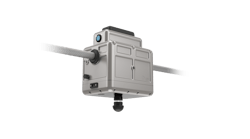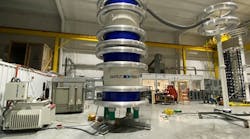NOJA Power's OSM range of Automatic Circuit Reclosers can be used in series with a set of single-phase disconnect links to meet the insulation coordination requirements specified in International Electrotechnical Commission (IEC) standard IEC 60071.
IEC 60071 is a two-part document that applies to three-phase AC systems with a highest voltage for equipment above 1 kV. The standard specifies the selection of the rated withstand voltages for the phase to earth-, phase to phase- and longitudinal-insulation and deals with the selection of insulation levels for equipment. The purpose of the document is to ensure that if insulation breakdown occurs due to an overvoltage event the failure will happen at a predetermined position away from personnel and be relatively simple and inexpensive to repair.
Traditionally, linesmen relied on switches incorporating contacts separated by a visible air gap to isolate distribution feeders (in addition to grounding the line to be worked on) for insulation co-ordination purposes, but because the contacts were exposed to pollution, weather and debris, they proved unreliable and caused network faults during normal operation.
Later, load-break switches using Sulphur Hexafluoride (SF6) insulation were used as a standalone solution because isolation integrity in the event of loss of the gas was assured due to the resultant air gap between the open contacts being wide enough to prevent flashover at normal system voltage. However, this type of load-break switch proved unpopular because linesmen could no longer visually confirm the enclosed contacts were open before starting work, and the SF6 gas used for insulation has a potent global warming potential of 23,900 times that of CO2[2].
Reclosers using enclosed contacts and vacuum interruption are not acceptable as a standalone solution for line isolation because, should the vacuum be lost, the resultant air gap between the contacts is insufficient to prevent flashover at normal system voltages.
NOJA Power OSM range ACRs use solid dielectric insulation and vacuum arc quenching to eliminate the SF6 used in conventional load-break switches. When used with the disconnect links, the ACRs address both drawbacks of insulation co-ordination using conventional load-break switches because the polluting SF6 gas is eradicated and the linesman can observe the break in the line at the disconnect links before starting work.
The disconnect links can’t be opened under normal load so the NOJA ACR is activated first to isolate the line before the disconnect links are moved.
“Safety is our number one priority and heavily influences the design of our ACRs,” explains Neil O’Sullivan, Managing Director of NOJA Power. “For example, the OSM range complies with arc fault containment and venting standards. If failure occurs, internal arcing is contained and any gases generated are safely vented.
“Just as importantly, NOJA Power ACRs in series with disconnect links meet the latest insulation co-ordination requirements. In addition, the environment benefits because there is no danger of pollution from SF6 gas, and the linesman is reassured because he can see the air gap in the feeder before starting work,” says O’Sullivan.



